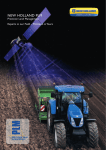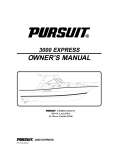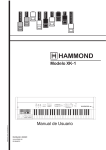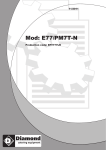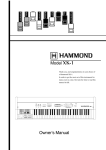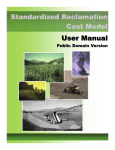Download ATI Technologies Lawn Mower Lawn Mower User Manual
Transcript
COPYRIGHT 2007 by ATI Corporation New Holland, PA 17557 U.S.A. DISCLAIMER THE INFORMATION IN THIS MANUAL IS PROVIDED TO PROMOTE THE SAFE USE OF, AND ASSIST THE OPERATOR IN ACHIEVING THE BEST PERFORMANCE FROM, THE PRODUCTS DESCRIBED HEREIN WHEN USED FOR THE INTENDED APPLICATION. Models Part Number Model Number Description 3 15-067-000 315-068-000 315-069-000 PL72 PL84 PL96 Box, Grader, Para-Level, Single, 6', Cylinder Only Box, Grader, Para-Level, Single, 7', Cylinder Only Box, Grader, Para-Level, Single, 8', Cylinder Only 000-166-407 Kit, Hydraulic, Single MEI/Mikrofyn, Includes Valve Assembly, Hoses, Fittings and Solenoid Cable 000-166-448 Kit, Hydraulic, Single Topcon, Includes System Five Remote, Power and Solenoid Cable (does not include Sensor Cable) 000-166-483 Kit, Hydraulic, Single Trimble, Includes Valve Assembly, Hoses, and Fittings 000-200-149 Kit, Cables, Topcon System Five, Includes Sensor/Solenoid Cable and Power/ Remote Cable 000-200-148 Kit, Cables, Trimble, Includes Junction Box with Solenoid Cable and Remote, Sensor Cable and Power Cable 315-575-000 Tractor Hitch NOTE: Optional accessories, Scarifier Assembly, installation and parts manual can be obtained from ATI Corporation or download from web site, www.level-best.com. ii Table of Contents Models...........................................................................................................................................................ii Table of Contents..................................................................................................................................iii Safety Information................................................................................................................................v Safety Precaution Definitions..................................................................................................................... v Warranty....................................................................................................................................................vi List of Illustrations...........................................................................................................................vii Notes............................................................................................................................................................viii Systems Features and Basic Operation.......................................................................................1 Purpose....................................................................................................................................................... 1 Components................................................................................................................................................ 1 Control Panel....................................................................................................................................... 2 Rotating Laser..................................................................................................................................... 2 Laser Sensor........................................................................................................................................ 2 Cables.................................................................................................................................................. 2 Hydraulic Valve...................................................................................................................................3 Equipment Set-Up .....................................................................................................................................3 Tractor Grading Box............................................................................................................................ 4 Job Site Set-Up........................................................................................................................................... 5 Set-Up for Level Grading.................................................................................................................... 6 Set-Up for Sloped Grading.................................................................................................................. 6 Benching And Operating............................................................................................................................8 Benching.............................................................................................................................................. 8 Benching with a Rod Eye.................................................................................................................... 8 Operation.............................................................................................................................................9 Troubleshooting...................................................................................................................................10 Specifications and Maintenance..................................................................................................12 Specifications............................................................................................................................................ 12 Dimensions........................................................................................................................................ 12 Maintenance..............................................................................................................................................13 Storage and Transport........................................................................................................................ 13 Cables and Hoses............................................................................................................................... 13 Machine.............................................................................................................................................13 Calibration.........................................................................................................................................13 Service......................................................................................................................................................13 Registration Card.................................................................................................................................15 iii Table of Contents (This page left blank) iv Safety Information • Always allow for clearance under the cutting edge of the machine when tuning the system or when switching to automatic control. Insufficient clearance could cause the machine to lift itself off the ground as its cutting edge attempts to achieve the programmed slope. This manual is furnished to you, the owner/operator, as a guide to get the greatest benefit from your Grading Box. ATI Corporation wants you to be able to get the most use out of your Grading Box through safe and efficient operation. Before attempting to operate the Grading Box, carefully read all sections of this manual. Be sure that you thoroughly understand all of the safety information and operating procedures. • Never adjust the position of the Laser Sensor when the system is in automatic control. • Never perform service work on your machine or the automatic control system when the system is in automatic control. Safety Precaution Definitions Dangers, Warnings, Cautions, and Notes are strategically placed throughout this manual to further emphasize the importance of personal safety, qualifications of operating personnel, and proper use of the grading box in its intended application. These precautions supplement and/or complement the safety information decals affixed to the unit and include headings that are defined as follows: • Install all safety panels and guards before operating your equipment. • Stay clear of all moving parts when the machine is in operation. • Keep all people clear of the machine when it is running. • Keep feet and other body parts from under the cutting edges of the machine at all times. • Read and comply with all safety recommendations of your Tractor/Skid Steer manufacturer, as outlined in its operator and service manuals. Indicates an imminently hazardous situation which, if not avoided, will result in death or serious injury. NOTE: References made to left, right, front, and rear are those directions viewed from behind the power unit and grading box. Indicates a potentially hazardous situation or practice which, if not avoided, could result in death or serious injury. NOTE: Some equipment depicted in illustrations may not reflect exact production model configurations. NOTE: All safety, operating, and servicing information reflects current production models at the time of publication of this manual. Indicates a potentially hazardous situation or practice which, if not avoided, will result in damage to equipment and/or minor injury. NOTE: ATI Corporation reserves the right to discontinue models at any time, change specifications, and improve design without notice and without incurring obligation on goods previously purchased and to discontinue supplying any part listed, when the demand does not warrant production. NOTE: Indicates an operating procedure, practice. etc., or portion thereof, which is essential to highlight. • Always use caution and safe operating practices when operating this equipment. • Always set the Automatic/Manual Switch on the Control Panel to MANUAL before leaving the operator’s seat or whenever the machine is not moving. Warranty This Laser Grading Box is designed and manufactured to high quality standards. ATI Corporation, therefore, guarantees this Laser Grading Box to be free from defect in workmanship and materials for one (1) year from purchase date. If the machine is used for rental purposes, the warranty is limited to ninety (90) days. Laser Controls, Vendored Components and Control Valve Parts are warranted separately by their respective manufacturers. Does not cover normal wear or failure due to hydraulic oil contamination. Misuse, abuse, misapplication, and unauthorized alterations will void this warranty. vi List of Illustrations Figure 1. Plane of Laser Light with Components of the Automatic Control System.......................................1 Figure 2. Valve Connection Details..................................................................................................................3 Figure 3. Components of the Automatic Control System on a Skid Steer........................................................3 Figure 4. Control Panel Mounting....................................................................................................................4 Figure 5. Components of the Automatic Control System on a Tractor.............................................................5 Figure 6. Method One: Align Rotating Laser with Grade Stakes.....................................................................6 Figure 7. Sight Over Rotating Laser.................................................................................................................6 Figure 8. Grade Stake with Elevation Mark.....................................................................................................7 Figure 9. Method Two: Align Rotating Laser with Grade Stakes.....................................................................7 Figure 10. Lube and Maintenance Chart.........................................................................................................14 vii Notes viii Systems Features and Basic Operation Purpose NOTE: It is the responsibility of the dealer or owner to select, install, and properly operate an automatic control system on this Laser Grading Box within the guidelines of this manual. The Level Best Laser Grading Box is a cost-efficient method for fine grading. Various capacities sized to fit the skid steer or tractor with a choice of automatic control systems are available. Laser-guided depth control provides unmatched measurement of plane from a single Rotating Laser. Grade information from a Rotating Laser is processed and automatically directs the grading box’s hydraulics to maintain the elevation of the cutting edge. The Laser Grading Box is intended to operate with an automatic control system providing accurate grade control. If desired, the Laser Grading Box can be operated without an automatic control system in one of two ways: Without any Valve/Manifold - The cylinder can be connected directly to the tractor or skid steer and the Laser Grading Box operated using the tractor or skid steer valve. Flow to the hydraulic cylinder is restricted to improve control. However, movement of the cutting edge can be coarse. Most automatic control systems can operate automatically or manually. • In manual control, the operator watches an indicator on the Laser Sensor or Control Panel and uses the controls to keep the box “On Grade”. • In automatic control, the automatic control system controls the box’s hydraulic cylinder to keep the box “On Grade”. With the Valve and No Control System - A switch can be installed to operate the electric valve from the tractor or skid steer, providing fine control of cylinder movement. However, raising and lowering of the cutting edge is dependant upon operator attentiveness and accuracy. Components The control system consists of 4 components: Rotating Laser – Provides a reference Plane of Laser Light over the job site (refer to Figure 1). Light plane may be level or set at an angle to match the slope of the ground. For the most accurate control and ease of operation, an automatic control system is used and recommended. This manual is for a skid steer or tractormounted, single cylinder Para-Level Laser Grading Box with customer-supplied laser controls. Laser Sensor – Mounted at a specific height on a mast on the Laser Grading Box, it determines the difference in depth based on the Plane of Laser Light. Figure 1. Plane of Laser Light with Components of the Automatic Control System Systems Features and Basic Operation Control Panel – Contains the logic of the automatic control system, processing data from the Laser Sensor and, if equipped, switches controlled by the operator. Use of any laser on a worksite is controlled by OSHA regulations found at 29 CFR 1926.54. Be familiar with these regulations before using any laser beacon used in conjunction with this system. Review and understand all literature provided with the Laser System before operating. Valve Assembly – Wired to the Control Panel, the valve meters hydraulic oil to the hydraulic cylinder for depth control. Control Panel The complexity of the Control Panel varies from system to system. Refer to the specific brand of system for specific details. Laser protection devices must be provided to all workers in the area if the laser system exceeds five (5) milliwatts. Refer to the literature provided with the system to determine the power output. If unsure of the strength of the laser system, anti-laser eye protection should be provided to all workers. Rotating Laser The Rotating Laser is the unit that creates the plane of laser light detected by the Laser Sensor. Most Rotating Lasers transmit a focused plane of laser light approximately 1000 ft. (300 meters). They are available in single grade, dual grade, and steep slope versions. They can be quickly and easily aligned to job site requirements without complicated calculation of angles. Laser Sensor The Laser Sensor detects the laser light generated by Rotating Lasers. The Laser Sensor sends to the Control Panel the location of the plane of laser light. The Control Panel then has the valve assembly drive the Grading Box's hydraulics accordingly. A dual slope Rotating Laser can be configured for level, single slope, or dual slope applications. Simply enter the required percent of grade and align the Rotating Laser to the axis (direction) to be graded. The Laser Sensor is mounted on the mast pole directly above the cutting edge of the box. • Percent of Grade. The change in elevation for every 100 feet (30 meters) graded. Cables Cables connect the various components together into a system. A single cable is provided with “open” wires at one end for attachment to the automatic control system or an electric switch. The other end has a 3-pin connector that mates with the hydraulic valve connector. • Slope. The change in elevation per foot (meter). Never look directly into a laser light or serious injury to the eye may occur. In general, incidental exposure of the laser to the eye will not do damage. However, avoid looking into the beam whenever possible. Use a target for viewing the laser spot. All cables must be secured with adequate cable length to avoid pinching, stretching and tight bending. Do not clamp cables to pipes or hoses that may generate high heat. Systems Features and Basic Operation Figure 2. Valve Connection Details Equipment Set-Up Hydraulic Valve The hydraulic valve is mounted on the frame of the Laser Grading Box. It is an electrically-actuated double-acting, single-section valve. Hoses and quick-couplers to attach it the tractor’s auxiliary hydraulics are included with the hydraulic kit. Skid Steer Grading Box 1. Provide power to the Control Panel from the skid steer's electrical system. Usually this involves a direct hookup to the battery. 2. The Laser Grading Box should be positioned on a level area for attaching to the skid steer. Start the skid steer and drive up to the attachment plate and secure per the manufacturer’s directions. The Level Best quick-attach plate is designed to be universal. An electrical cable is also provided. One end of the cable has a 3-pin connector for the valve. The other is open and can be attached to the Control Panel of the automatic control system as required. Refer to Figure 2 for wiring details of the cable and conductor functions. The valve accepts a 12 VDC proportional current signal from the Control Panel. NOTE: If the skid steer’s pins do not fit securely into the rectangular holes at the base of the attachment plate, these holes can be notched larger to accept the pins. If you require a proportional time or 24 volt valve, contact ATI Corporation. Figure 3. Components of the Automatic Control System on a Skid Steer Systems Features and Basic Operation 3. After installation, ensure that the Laser Grading Box is level. The loader arms must be completely lowered and the bucket cylinders set so the tires of the Laser Grading Box are on the ground. Cables must be securely fastened and pinch/rubpoints eliminated. Do not fasten to hydraulic lines which may operate at high temperatures. Ensure sufficient cable length to allow movement of the machine. Verify that the Laser Grading Box is level by observing that the main frame is horizontal to the ground. Turn the skid steer engine OFF when connected. 7. Connect the various cables to the control system components. 4. Mount the Control Panel on the bracket attached to the hydraulic valve. 8. If possible, set the automatic control system to manual mode to prevent unintended movement of the Laser Grading Box. Always have system in Manual setting when not operating the skid steer. Tractor Grading Box 1. Provide power to the Control Panel from the tractor's electrical system. Usually this involves a direct hookup to the battery. 2. The Laser Grading Box should be positioned on a level area for attaching to the tractor. Start the tractor and back up to the Laser Grading Box. Attach the unit with the hitch pins supplied. Figure 4. Control Panel Mounting 5. Connect the Laser Grading Box’s hydraulic hoses with quick couplers to the auxiliary hydraulic ports of the skid steer. The Laser Grading Box’s hydraulic manifold is marked “P” and “T” where the pressure and return (tank) hoses connect. 3. After installation, ensure that the Grading Box is level. Set the pitch of the Laser Grading Box by adjusting the top and lower links. NOTE: “P” means pressure (supply) and “T” means tank (return). Refer to the skid steer Owner’s Manual for identifying the “P” and “T” Auxiliary Hydraulic Ports. 4. Mount the Control Panel on the right rear fender of the tractor or other easily accessible location. 6. Insert the mast pole in the holder until it rests at the bottom of the tube. Tighten the tee handle to secure the mast. Clamp the Laser Sensor near the top of the mast so it is higher than any local obstruction including the skid steer cab or fall protection devices. (Refer to Figure 3). Verify that the Laser Grading Box is level by observing that the main frame is horizontal to the ground. Turn the tractor engine OFF when connected. 5. Connect the Laser Grading Box’s hydraulic hoses with quick couplers to the tractor quick couplers. The Laser Grading Box’s hydraulic manifold is marked “P” and “T” where the pressure and return (tank) hoses connect. Systems Features and Basic Operation Figure 5. Components of the Automatic Control System on a Tractor Job Site Set-Up NOTE: “P” means pressure (supply) and “T” means tank (return). Refer to the tractor Owner’s Manual for identifying the “P” and “T” Auxiliary Hydraulic Ports. The following are guidelines for setting up a Rotating Laser for both level job sites and sloped job sites: 6. Insert the mast pole in the holder until it rests at the bottom of the tube. Tighten the tee handle to secure the mast. Clamp the Laser Sensor near the top of the mast so it is higher than any local obstruction including the tractor cab or fall protection devices. (Refer to Figure 5). • Choose a location for the Rotating Laser where obstructions, such as trees and buildings, can not block the plane of laser light. The Laser Sensor needs to be able to sense the plane of laser light at all times. • Whenever possible, set up the Rotating Laser and the Laser Sensor at a height above the machine’s cab. This prevents the cab or rollover structure from blocking the plane of laser light as the machine moves around the job sites. Cables must be securely fastened and pinch/rubpoints eliminated. Do not fasten to hydraulic lines which may operate at high temperatures. Ensure sufficient cable length to allow movement of the machine. • Be sure the Rotating Laser and Laser Sensor are operating in compatible modes with a head speed that is recognized by the other device. 7. Connect the various cables to the control system components. 8. If possible, set the automatic control system to manual mode to prevent unintended movement of the Laser Grading Box. Always have system in Manual setting when not operating the tractor. Systems Features and Basic Operation Set-Up for Level Grading If the job site is to be level, the set-up of the Rotating Laser is simple. Since no slope is required in either axis, the Rotating Laser does not need to be aligned. The Rotating Laser will provide a level plane of laser light in all directions. 1. Locate the Rotating Laser following the guidelines above. 2. Apply power to the Rotating Laser. Level the Rotating Laser (some Rotating Lasers will automatically level, others will need manual adjustment). Figure 6. Method One: Align Rotating Laser with Grade Stakes 4. Set the counter on the Rotating Laser for both axis to 0.0000% (If needed, see the Rotating Laser Operation Manual). 3. Set the counters for both axis at 0.000% (If needed, see the Rotating Laser Operation Manual). 5. Roughly align one of the axis to the grade stakes by sighting over the top of the Rotating Laser (Refer to Figure 7). 4. Bench the machine. See the “Benching and Operating” procedure in this section. Set-Up for Sloped Grading If the job site is to be graded for a single or dual slope, the Rotating Laser requires its axis to be aligned for the job site. The Rotating Laser will then provide a plane of laser light at the required slope(s). The following procedures are for two typical examples of job sites requiring sloped grades. Remember, each job site is unique, so consider the following methods as guidelines and not as the only methods possible. Figure 7. Sight 6. Align the plane of laser light. a.Set a grade rod with Rod Eye Receiver on the far grade stake and adjust the rod until the Rod Eye Receiver indicates “On Grade.” Method One: 1. Set a minimum of two grade stakes exactly in line with one of the axis to be graded (Refer to Figure 6). b.On the axis not aligned with the stakes, enter on the Rotating Laser: 5.000%. Allow the Rotating Laser to level itself to this new position, if needed. 2. Place the Rotating Laser in line with the two grade stakes. 3. Switch on the Rotating Laser. Level the Rotating Laser (some Rotating Lasers will automatically level, others will need manual adjustment). Over Rotating Laser c.Check the Rod Eye Receiver again. • If the Rod Eye Receiver indicates “On Grade”, the plane of laser light is aligned correctly. Systems Features and Basic Operation 4. Roughly align one of the axis to the grade stakes by sighting over the top of the Rotating Laser (Refer to Figure 7). • If the Rod Eye Receiver indicates the plane of laser light is too high or too low, have a second person rotate the Rotating Laser on the tripod in small steps until the Rod Eye Receiver indicates “On Grade.” 5. Set both the counters on the Rotating Laser to the required percent of grade (If needed, see the Rotating Laser Operation Manual). 7. Enter on the Rotating Laser the required percent of grade for each axis and allow the Rotating Laser to level itself again. 8. Bench the machine. See the “Benching and Operating Your Machine” procedure in this section. Method Two: NOTE: This procedure requires that the elevations of the grade stakes are correct and aligned to the slope or percent of grade required. 1. Set a minimum of two surveyed grade stakes. The stakes must have elevation information. 2. Place the Rotating Laser a few feet (meters) behind the first grade stake and in line with one of the far grade stakes (it is not critical to align the Rotating Laser exactly). (Refer to Figure 9.) Figure 9. Method Two: Align Rotating Laser with Grade Stakes NOTE: The Grade Rod must be held plumb for each of the readings taken in the following steps. NOTE: Follow the guidelines at the beginning of this section when placing the Rotating Laser. 6. 3. Switch on the Rotating Laser. Level the Rotating Laser. Establish the H.I. (height of the instrument) for the plane of laser light. a.Align the bottom of the Grade Rod to the mark on the near grade stake. b.Adjust the Rod Eye Receiver up and down until it indicates “On Grade.” c.Adjust the Rod Eye Receiver for any cut or fill amount indicated by the grade stake. • If the grade stake shows a cut, extend the Grade Rod and Rod Eye by the amount shown as a cut. • If the grade stake shows a fill, lower the Rod Eye by the amount shown as fill. Figure 8. Grade Stake with Elevation Mark Systems Features and Basic Operation Benching 7. Align the plane of laser light. a.Align the bottom of a Grade Rod to the mark on the far grade stake. 1. Move the machine to an area which is close to finish grade or, using the manual controls on the control system, grade a small area close to finish grade. b.Check the Rod Eye Receiver. • If the Rod Eye Receiver indicates “On Grade,” the plane of laser light is aligned at the correct slope. NOTE: Finish grade can be checked several times during the grade process to “zero” in on final grade. • If the Rod Eye Receiver indicates the plane of laser light is too high or too low, have a second person rotate the Rotating Laser on the tripod in small steps until the Rod Eye Receiver indicates “On Grade.” 2. If equipped, set the automatic control system to manual. 3. Turn the Laser Sensor and Rotating Laser ON. 4. If equipped, set the deadband tolerance to the minimum possible. NOTE: If it was necessary to rotate the Rotating Laser a significant amount at the far stake, then the original reading at the near stake may be out of tolerance. Check the setting again and make minor adjustments as required. NOTE: Use narrow deadband for benching. 5. Adjust the height of the Laser Sensor until it is “On Grade”. For: Telescoping Masts, loosen the locking knob on the mast and raise or lower the Laser Sensor. Tighten the locking knob when correct. 8. Bench the machine. NOTE: If needed, check the elevations on both the plane of laser light and the grade stake elevations by setting the bottom of the Grade Rod at any stake’s grade mark and checking the Rod Eye Receiver for the “On Grade” indication. Non-Telescoping Masts, loosen the mounting knob for the Laser Sensor and raise or lower the Laser Sensor. Tighten the mounting knob when correct. NOTE: Most materials graded must later be compacted. To compensate for the compacting distance, lower the Laser Sensor. This raises the cutting edge by the same distance. The distance the Laser Sensor is lowered depends on the material. Benching And Operating Before benching, the plane of laser light must be set at its proper slope. Benching is the process of setting the relationship between the Laser Sensor and the Rotating Laser or benchmark. Failure to properly bench the system before grading will result in an unacceptable grade. Benching with a Rod Eye To bench the Laser Sensor follow the process listed below: The goal is to have the Laser Grading Box approximately 1/2 full during operation. If, during rough grading, a lot of material needs to be removed from a site, the Laser Sensor should be set several inches higher than finished grade. As material is removed, the Laser Sensor can be lowered and the site regraded. This may need to be repeated several times until finished grade is achieved. 1. Turn on the Rotating Laser. Attach a Rod Eye to a measuring pole and turn on. Set the base of the measuring pole on the benchmark and adjust the measuring pole so the Rod Eye emits a solid “On Grade” tone (compensate for slab thickness and compaction if needed). Systems Features and Basic Operation 2. Find an area to be graded that is close to specified grade. Start the skid steer or tractor, engage the auxiliary hydraulics and move the unit to that location. Manually raise or lower the Laser Grading Box’s cutting edge until it is even with the bottom of the measuring pole when the Rod Eye is emitting the “On Grade” tone or resting on the ground if already at grade. • In some situations, the automatic control system may require a cut deeper than the machine can handle. The machine may lose traction, stall the engine, or the wheel frame will be lifted off the ground to the maximum stroke of the cylinder as the cutting edge tries to reach finished grade. If this occurs, set the Auto/Manual Switch to MANUAL and use the Raise/Lower Switch to raise the cutting edge until the machine can push the material. Make multiple passes to cut the area to closer to finished grade and then go back to AUTO control. This allows the high spots to be gradually removed. 3. Making sure the automatic control system is set to manual and the deadband tolerance is at its minimum, move the Laser Sensor to a height on the mast pole where it indicates the beam is in the “On Grade” position and is unobstructed by any object. Operation NOTE: In rough grading situations, the automatic control system can usually operate as an “Indicate Only” system and the machine controlled manually. After the area is rough graded, return to automatic control. After the Laser Grading Box is connected and the automatic control system is calibrated, operation can begin. The operational goal is to drive over the area to be graded with the box 1/2 full of material and the Control Panel’s Green Light always illuminated. 4. After several passes with the Laser Grading Box, stop and turn off the skid steer or tractor. Place the base of the measuring pole on the graded area check grade elevation. 1. When seated in the Operator’s seat, start the skid steer or tractor and set the automatic control system to operating in automatic mode. 5. After a rough grade is achieved, reduce the deadband tolerance to meet the job tolerance requirements. With a tighter deadband, the speed of the skid steer or tractor must be decreased for optimum finish. 2. If equipped, set the deadband tolerance to a large value. NOTE: Most materials graded must later be compacted. To compensate for the compacting distance, lower the Laser Sensor. This raises the box’s cutting edge by the same distance. The distance the Laser Sensor is lowered will depend on the material. 3. Drive the machine forward or reverse (The Para-Level Grading Box has front and rear cutting edges). The automatic control system constantly senses the plane of laser light to maintain the cutting edge of the box at the required elevation. Note the following during operation: Troubleshooting Symptom Laser Grading Box does not raise or lower. Laser Grading Box moves in opposite direction. Potential Cause Control Panel not turned on. Remedy Apply power. No hydraulic flow to Laser Grading Box. Ensure hydraulic control handle of skid steer or tractor is in correct position. Ensure auxiliary hydraulics are ON or in continuous flow mode. Cables not connected correctly. Refer to the automatic control system documentation. Move directional valve spool manually using the overrides on the end of the directional valve. Be sure to stay clear of any moving parts of the Laser Grading Box. If the Laser Grading Box moves, refer to Electrical problems. If the Laser Grading Box does not move, refer to Hydraulic problems. Electrical Problems Refer to the automatic control system documentation. Hydraulic problems. Confirm hydraulic flow through the manifold and returning to the power source through the “T” hose. Hydraulic flow reversed. Contact ATI Corporation for help troubleshooting the hydraulic manifold. Confirm the pressure is going in the “P” port. Verify control handle is moving in desired direction. 10 Troubleshooting Symptom Box has trouble staying on grade. Potential Cause Rotating Laser out of range. Remedy Ensure Laser Sensor is within specified operating range of Rotating Laser. Laser beam being reflected. Ensure Rotating Laser’s light is not reflecting off other surfaces (windows, windshields, mirrors, etc.) causing multiple readings by the Laser Sensor. Multiple laser beams. Ensure that there are no other lasers operating on the job site or nearby. Laser deadband set too narrow. Ensure the deadband tolerance is set for rough grading. Travel speed is too fast for grade tolerance. Slow down. Hydraulic response too quick. Decrease the Gain Selection Switch setting. Hydraulic flow reversed. Confirm the pressure is going in the “P” port. 11 Specifications and Maintenance Specifications Dimensions Model Box Width Overall Width PL72 72 in. (183 cm) 74.8 in. (190 cm) Total Length Box Capacity, Front Box Capacity, Rear Weight PL84 84 in. (213 cm) 86.8 in. (220 cm) PL96 96 in. (244 cm) 98.8 in. (251 cm) 66 in. (168 cm) 11.5 ft3 (0.33 m3) 7.0 ft3 (0.20 m3) 1530 lbs. (694 kg) 13.4 ft3 (0.38 m3) 8.0 ft3 (0.23 m3) 1590 lbs. (721 kg) 12 15.3 ft3 (0.43 m3) 9.0 ft3 (0.25 m3) 1650 lbs. (739 kg) Specifications and Maintenance Maintenance Calibration Perform periodic calibration checks of the Rotating Laser System as outlined in its Operation Manual to ensure accurate performance. The rugged and durable automatic control system is built to last, but as with all equipment, a few minutes of routine care, maintenance, and cleaning can extend the life of the system. Service Storage and Transport If the automatic control system is not functioning properly, the first step is to determine the problem component. Use the Troubleshooting Chart to determine possible causes and remedies. Most often the Laser Grading Box and its hydraulic controls remain on the machine. However, the Control Panel, Laser Sensor, Coiled Sensor Cable and Solenoid Cable should be stored in a safe, protected place when not in use. Protect the cable connections by installing any covers supplied. Cables and Hoses The automatic control system is a highly sophisticated electronic system. Do not attempt repairs to the components. Contact your local dealer if you have any problems. Check all cables and hoses regularly for signs of wear and damage. Keep cable connections clean and free from dirt and corrosion. If a cable has been damaged, do not attempt to repair. Incorrect or poor connections can cause damage to your automatic control system. When applicable, check the hydraulic hoses. Look for areas where the hoses could rub against each other or another object as they expand and contract under pressure. Check the hydraulic fittings for tightness. Machine Check areas that affect the Automatic Control system function and accuracy, such as looseness or play in the cylinders or wear on the box’s cutting edge. Looseness in the connection to the tractor/ skid steer, such as in the adaptor plate/3-point hitch, will cause inaccurate depth positioning. Also check the tractor/skid steer routinely for wear to its components, such as loader pins and 3-point linkage, ensuring it is operating properly. 13 Specifications and Maintenance Figure 10. Lube and Maintenance Chart 14 Registration Card By buying this product, you, the purchaser of this product, agree to the following: To the fullest extent permitted by law, the purchaser of this product shall indemnify and hold harmless ATI Corporation and its authorized dealer from and against claims, damages, losses and expenses, including but not limited to attorney’s fees, arising out of or resulting from the use of the product, provided that such claim, damage, loss or expense is attributable to bodily injury, sickness, disease or death, or to injury to or destruction of tangible property, but only to the extent caused by the negligent acts or omissions (Including but not limited to misuse or alteration of the product) of the purchaser, anyone directly or indirectly employed by the purchaser or anyone for whose acts the purchaser may be liable, regardless of whether or not such claim, damage, loss or expense is caused in part by a party indemnified hereunder. In claims against any person or entity indemnified under this agreement by an employee of the purchaser, anyone directly or indirectly employed by the purchaser or anyone for whose acts the purchaser may be liable, the indemnification obligations shall not be limited by a limitation on amount or type of damages, compensation or benefits payable by or for the purchaser under worker’s compensation acts, disability benefit acts or other employee benefit acts. CUSTOMER COPY Dealer ____________________________________Date Installed ________________________ Control Panel Model # _______________________Serial # _____________________________ Grading Box Model # ________________________Serial # _____________________________ Laser Sensor Model # ________________________Serial # _____________________________ Dealer Name ___________________________________________________________________ Street _________________________________________________________________________ City, State, Zip _________________________________________________________________ Telephone _________________________________Fax_________________________________ Signature ______________________________________________________________________ DETACH AND MAIL TO ATI CORPORATION • 250 EARLAND DRIVE • NEW HOLLAND, PA 17557 or FAX to (717) 354-2162 MANUFACTURER’S COPY Dealer ____________________________________Date Installed ________________________ Control Panel Model # _______________________Serial # _____________________________ Grading Box Model # ________________________Serial # _____________________________ Laser Sensor Model # ________________________Serial # _____________________________ Customer Name ________________________________________________________________ Street _________________________________________________________________________ City, State, Zip _________________________________________________________________ Telephone _________________________________ Fax_________________________________ Signature _____________________________________________________________________ 15

























